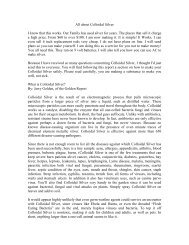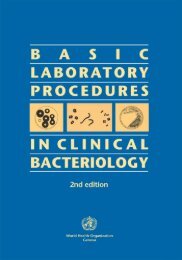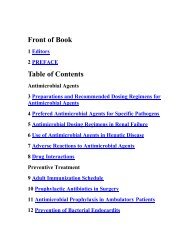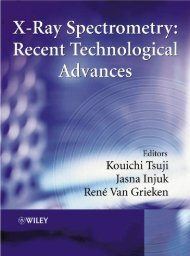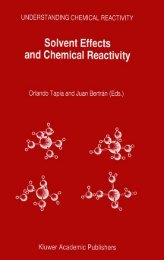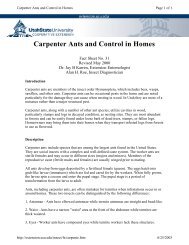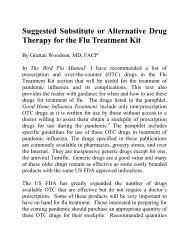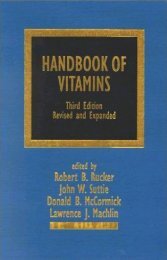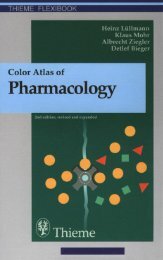The Nutritional Biochemistry of Chromium(III) - Survival-training.info
The Nutritional Biochemistry of Chromium(III) - Survival-training.info
The Nutritional Biochemistry of Chromium(III) - Survival-training.info
Create successful ePaper yourself
Turn your PDF publications into a flip-book with our unique Google optimized e-Paper software.
Introduction: A history <strong>of</strong> chromium studies (1955–1995) 11To an outsider reviewing literature on chromium and diabetes/obesity, the fieldis most striking for two features: its nearly complete lack <strong>of</strong> biomedical or clinicalunderstanding and its high degree <strong>of</strong> polarization . As in all fields with more heat thanlight, the reason has been the incomplete ability to measure and test key factors . <strong>The</strong>high degree <strong>of</strong> politicization and polarization in this field is characterized by unprovenclaims and counterclaims and suspicion among investigators. Concerns about possiblecommercial bias and potential conflict <strong>of</strong> interest have naturally emerged. Reports <strong>of</strong>benefits <strong>of</strong> supplementation (e.g., that lean tissue is increased and fat decreased bychromium in athletes in <strong>training</strong>) [68] that were not confirmed by several subsequentstudies [69–71] have furthered these concerns.<strong>The</strong> first nutritional, biochemical, or medicinal studies with Cr(pic) 3 were reportedin 1989 [68]. Evans found that in double-blind, crossover studies volunteers taking200 g/day chromium as Cr(pic) 3 (compared to taking placebos) had decreased totalcholesterol, LDL cholesterol, and apolipoprotein B and increased apolipoprotein A1[68–72]. In a similarly designed study, eight <strong>of</strong> eleven adult-onset diabetic patientsdisplayed positive effects with chromium supplementation (vide infra). Two studies byEvans with young men participating in weight <strong>training</strong> resulted in significant losses inbody fat and increases in lean muscle mass with chromium supplementation [68]. <strong>The</strong>sehuman studies were followed by studies with rats and humans [63, 66, 73]. Studies<strong>of</strong> cultured rat skeletal muscle myoblasts found increased insulin internalization andaccompanying glucose and leucine uptake by cells in media containing 1 M Cr(pic) 3but not containing the same concentration <strong>of</strong> chromic chloride, chromium nicotinate,or zinc picolinate [66]. <strong>The</strong> results were postulated to result from increased membranefluidity. Rats fed Cr(pic) 3 , but not rats fed chromium nicotinate (1 g Cr/g diet for 200days), had decreased plasma glucose and glycated hemoglobin [63]. In another study,similar results were observed after 1000 days on the diet; also 80% <strong>of</strong> rats on Cr(pic) 3were alive after 41 months, while all rats fed equivalent amounts <strong>of</strong> chromium nicotinateor chromium chloride had died [73].<strong>The</strong> results <strong>of</strong> the first human studies [68, 72] were questioned rapidly byLefavi [74] and Lefavi, Anderson, et al. [75]; Lefavi pointed out that the reported4.6-pound lean body mass increase in males and 4.0-pound increase in females in12 weeks <strong>of</strong> a weekly aerobics class were “preposterous” and that the studies werepoorly controlled and had few subjects [74].<strong>The</strong> history leading to the first publication in 1989 has been excellently summarizedby Forrest Neilsen <strong>of</strong> the USDA (Grand Forks Human Nutrition Research Center)[76]. While examining the use <strong>of</strong> zinc picolinate to treat children with acrodermatitisenteropathica, a genetic disorder that results in the inability to absorb zinc from cow’smilk, Gary Evans, employed by the Grand Forks Human Nutrition Research Center,found that zinc and other metal picolinates were absorbed better than the correspondingmineral salts. Evans patented the process <strong>of</strong> synthesizing coordination complexes <strong>of</strong>picolinic acid [76]. Nutrition 21 licensed the patent from USDA in 1986 and supportedEvans research leading to the 1989 publications. “In other words, contrary to what manyadvertisements touting chromium picolinate lead many to believe, the USDA patentis not specific to chromium, nor does it mention that chromium picolinate has anybeneficial effects claimed for this form <strong>of</strong> chromium supplement” [76].



